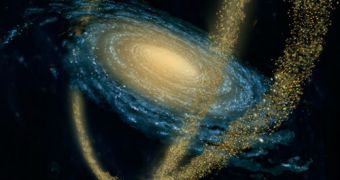In a new study, researchers show for the first time that smaller galaxies around the Milky Way are indeed shredded to pieces by the massive tidal interactions they have with out home galaxy.
The research, which will be published in the upcoming October issue of the esteemed Astrophysical Journal, also shows that massive galaxies such as our own do not form this large from the get-go.
Rather, they represent the balanced form of multiple galactic mergers, which usually see the large structure ripping apart and consuming its smaller counterparts.
Astronomers had previously assumed that the outer fringes of the Milky Way contain numerous smaller galaxies, which are in the process of getting destroyed, and integrated into the larger structure.
What experts managed to discover was a fully formed galaxy, that is currently in the midst of being gobbled up. This was never observed in past studies.
The Hercules satellite galaxy is the only known cosmic structure to be found in this intermediary stage.
The halo surrounding our galaxy has some time ago been proven to contain large numbers of minor stellar systems, but experts have fallen short of discovering actual, fully-formed galaxies.
The stellar clusters however proved to have interesting properties, which suggested that they are galaxies in their own right, despite having highly-elliptical shapes.
Data and computer models indicated that the structures were capable of exhibiting cohesion even at these high degrees of stretching. This shows that they are indeed galaxies, and that the Milky Way is pulling on them vigorously.
Due to the intense gravitational pull our galaxy exerts, it tends to attract nearby galaxies that are smaller, and then gobble them up.
Eventually, we are bound to slam into the Andromeda Galaxy, an estimated 4 billion years from now. The merger is bound to be extremely energetic, and to produce an even larger cosmic structure.
The two black holes at the center of these two formations, which are already supermassive in their own right, will most likely unite as well, producing an enormous dark behemoth.
When two galaxies collide, they also tend to stir up the gas inside them, which leads to extensive stellar production in the areas where contact is made.
A clear example in this direction are the Antenna Galaxies, which reveal large numbers of young, blue stars at the point of contact, Universe Today reports.

 14 DAY TRIAL //
14 DAY TRIAL //